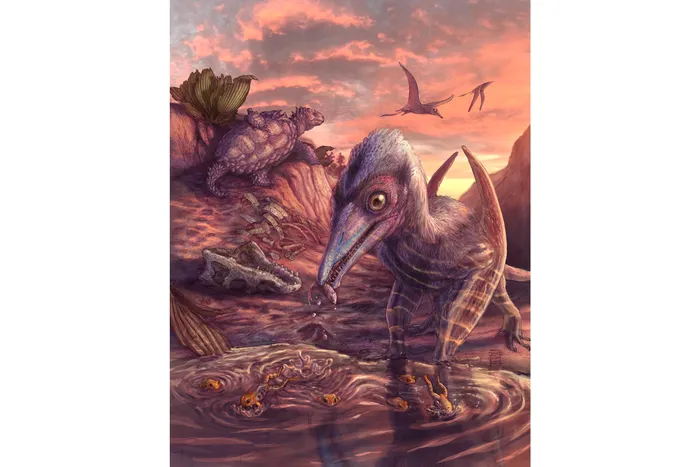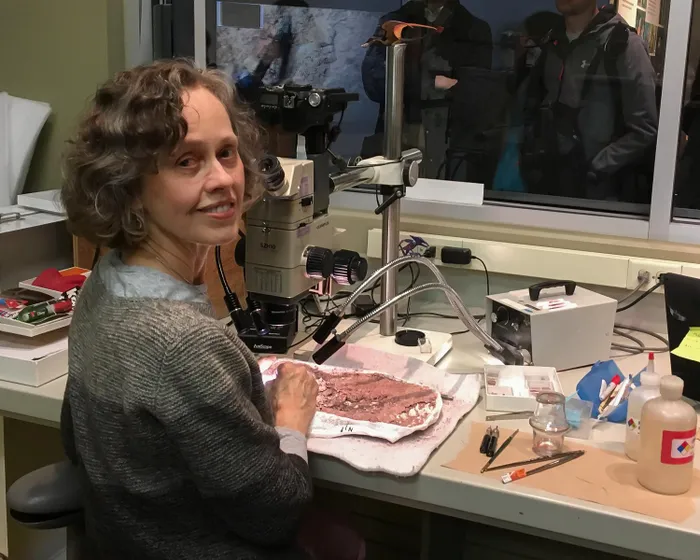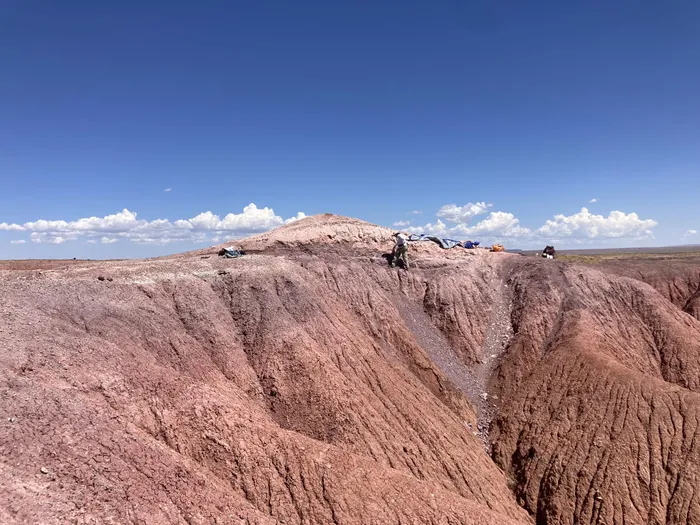Discovery of North America's oldest Pterosaur at Petrified Forest National Park

An artist’s reconstruction of the newly discovered species of pterosaur at Petrified Forest National Park in Arizona, where the fossil was discovered.
Image: Brian Engh/Smithsonian Institution
At a remote bone bed in Arizona, dense with fossils dating back around 209 million years, a Smithsonian-led team of researchers has discovered North America’s oldest known pterosaur, according to a news release.
Pterosaurs were the first vertebrates to develop powered flight, soaring above dinosaurs and other surreal creatures that called the prehistoric world home. The finding, detailed in an article in PNAS published Monday, offers clues to the evolution of the winged reptiles, which have more than 150 named species, including the Hollywood favourite - the pterodactyl.
Before the study, there were only two known Triassic pterosaurs from North America, Ben Kligman, a paleontologist at the Smithsonian’s National Museum of Natural History and an author on the study, said in an email. This is the only early pterosaur globally whose precise age has been determined. - information that is crucial to understanding “how a fossil animal fits into patterns of evolutionary and environmental change,” he said.
Suzanne McIntire, formerly a volunteer with the museum, unearthed the fossil. “What was exciting about uncovering this specimen was that the teeth were still in the bone, so I knew the animal would be much easier to identify,” she said in a statement.

Suzanne McIntire, a longtime volunteer at the Smithsonian’s FossiLab, discovered the new pterosaur fossil before her retirement last year. The new species was named in her honor.
Image: Bill King/Smithsonian Institution
The pterosaur’s jaw holds worn-down teeth, suggesting it ate fish with armored scales, and the creature “would have been small enough to comfortably perch on a person’s shoulder,” according to the release.
The new species is called the “ash-winged dawn goddess,” but it could also be considered a small nightmare for anyone imagining a winged reptile on their shoulder. Regardless, it’s a noteworthy discovery from the Petrified Forest National Park site, from which teams at the museum have uncovered more than 1,200 individual fossils, including fish scales, teeth and fossilized poop.
The fossils offer a window into a vibrant, bygone ecosystem, where animals such as giant amphibians, some up to six feet long, and armored crocodile relatives lived among “evolutionary upstarts” such as frogs, turtles and pterosaurs. “Fossil beds like these enable us to establish that all of these animals actually lived together,” Kligman said.
Among the findings was an ancient turtle “with spike-like armor and a shell that could fit inside a shoebox,” the news release says. It’s believed to have lived around the same time as the oldest known turtle, suggesting the creatures spread across the supercontinent Pangaea quickly. “Surprising for an animal that is not very large and is likely walking at a slow pace,” Kligman noted.

Kay Behrensmeyer, curator of vertebrate paleontology at the Smithsonian’s National Museum of Natural History, documents a bone bed at the Petrified Forest National Park in Arizona on May 23, 2023.
Image: Ben Kligman/Smithsonian Institution
Contrary to common belief, pterosaurs are not dinosaurs - their name comes from “winged lizard” in Greek. Some were the size of paper airplanes while others were as big as fighter jets and feasted on baby dinosaurs. They went extinct around 66 million years ago.
The early evolution of pterosaurs is something of a mystery as they appeared in the fossil record some 215 million years ago with fully evolved wings, Kligman noted. Bones of pterosaurs from the Triassic era, about 251.9 to 201.3 million years ago, are also small, thin and often hollow, so they are easily destroyed before fossilization.
Scientists have named the newly discovered pterosaur Eotephradactylus mcintireae. The genus name, Eotephradactylus, refers to Eos, the goddess of dawn; tephra translates to ash, and dactyl refers to the fingerlike wings - referencing volcanic ash at the site of its discovery and the animals’ position near the base of the pterosaur’s evolutionary tree. The species name is a callback to its discoverer, McIntire.
The unearthed fossil is “one of the only early pterosaurs whose anatomy can be observed in a detailed way in three dimensions,” Kligman said.
Its teeth are especially noteworthy as they’re fused into the socket, a feature shared with small, slender Triassic reptiles known as lagerpetids, a group which some hypothesize may be closely related to pterosaurs.
Kligman called the setting of the finding, which he described as “a river system flowing through the arid sub-tropical floodplains of central Pangaea,” unusual for early pterosaurs, and said there may be similar river deposits from other Triassic rocks that can also preserve pterosaur bones.
He said they hope “this creates a new search-image for filling gaps in the early evolution of pterosaurs.”
Related Topics: